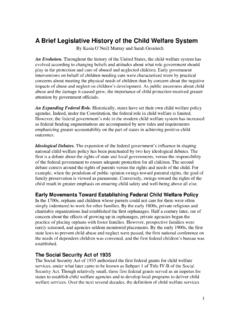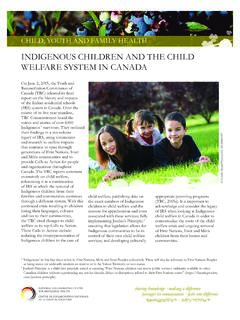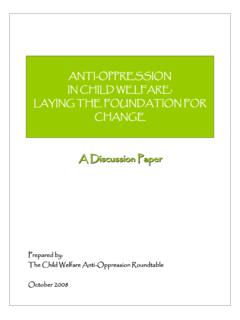Transcription of Family Engagement: Partnering With ... - Child Welfare
1 BULLETIN FOR. PROFESSIONALS. September 2016. Family engagement : WHAT'S INSIDE. Partnering With Families The benefits of Family to Improve Child Welfare engagement Outcomes Strategies for engaging Engaging families in the casework process families at the practice level promotes the safety, permanency, and well- being of children and families in the Child Engaging parents as Welfare system and is central to successful peer mentors at the practice. Effective Family engagement program level occurs when Child Welfare practitioners actively collaborate and partner with Family Promoting Family engagement at the members throughout their involvement with systems level the Child Welfare system, recognizing them as the experts on their respective situations Conclusion and empowering them in the process. Additional resources Children's Bureau/ACYF/ACF/HHS.
2 | Email: | Family engagement : Partnering With Families to Improve Child Welfare Outcomes Family engagement is a Family -centered and strengths- based approach to making decisions, setting goals, and achieving desired outcomes for children and families. At Family Empowerment its best, Family engagement encourages and empowers Recognizing the many benefits that come with families to be their own champions, working toward case Family engagement , the Children's Bureau goals that they have helped to develop based on their Capacity Building Center for States, part of specific Family strengths, resources, and needs. This the broader Child Welfare Capacity Building partnership between caseworkers and families is founded Collaborative, is endorsing a framework of Family on the principle of communicating openly and honestly in empowerment at all levels of Child Welfare .
3 The a way that supports disclosure of culture, Family dynamics, Center is working with States to assess their and personal experiences to meet the individual needs of Family empowerment models and their capacity every Family and Child . Additionally, Family engagement to represent Family interests at the practice, is recognized as essential to success across the human program, and policy levels. services and education fields and is now considered a For more information, visit the Capacity Building core competency in educational programs accredited by Collaborative Center for States website at https://. the Council on Social Work Education (California State University, Institute for Community Collaborative Studies, Family -empowerment/. 2014). This bulletin for professionals provides an overview of the foundational elements of the Family engagement Rather than a single tool, Family engagement represents approach, followed by strategies including State a mindset and approach that can reap extensive benefits, and local examples and promising practices for including: implementing this approach at the case level, peer level, and systems level.
4 Family preservation. Involving Family members early in the casework process may eliminate the need for a Child The Benefits of Family engagement to be placed outside of the home. A Family engagement approach to casework views families as the experts on their unique challenges and seeks to An enhanced helping relationship. A Family 's belief that support them in developing solutions. This strengths- all its members are respected and that its strengths, based approach empowers and encourages families to challenges, concerns, and cultural differences are partner with Child Welfare professionals to plan the best recognized and accepted strengthens the relationship services and resources for the Family to ensure Child safety with the caseworker. This creates a confidence in the and, in turn, improve outcomes for children and families.
5 Process that increases the chances for a successful Including families in decision-making and planning intervention. processes enhances the fit between Family needs and Increased Family buy-in. Families are more likely to services and makes it more likely the Family will participate commit to achieving case goals when they help to make in services and complete the case plan (Bossard, Braxton, decisions about a plan that will affect them and their & Conway, 2014). children. This material may be freely reproduced and distributed. However, when doing so, please credit Child Welfare Information Gateway. This publication is available online at 2. Family engagement : Partnering With Families to Improve Child Welfare Outcomes Expanded options. The inclusion of kin and extended planning, reviews, and closure. Training caseworkers in Family members early in case planning increases the reactance theory reframing client resistance as a number of individuals willing to help with Child care, normal and expected response to a lost or threatened transportation, etc.
6 , and expands placement and personal freedom may be helpful (Mirick, 2014). permanency options for children when in-home care is Other factors that may impede engagement include not feasible. The caseworker should defer to the Family to issues related to poverty, single parenting, substance identify potential helpful connections, recognizing that use and mental health, individual caseworker bias, lack some people who play an important role may be fictive of cultural competence, and agency culture (UC Davis kin those who may not be related, but who have an Human Services Northern California Training Academy, emotionally significant relationship with the Family or 2009). Some of these Family stressors particularly Child . substance use, mental health, and cultural barriers often Improved quality and focus of caseworker visits. benefit from intentional collaboration across service The partnership developed between the Family and sectors, such as behavioral health and the education caseworker enhances the assessment process and the system.
7 Level of engagement , resulting in more constructive To encourage Family engagement across disciplines, meetings and more positive outcomes (Gladstone et al., the Children's Bureau launched the Family engagement 2012). Inventory (FEI) in December 2014 as a means of infusing Enhanced Family decision-making skills. Involvement Family voice and strengthening families in the many in a strengths-based decision-making process systems that serve children: Child Welfare , juvenile where appropriate approaches to problem-solving are justice, behavioral health, early childhood education, modeled gives Family members new strategies for and education. The FEI is designed to provide updated communicating and problem-solving. information to those who work directly with children and families and those who manage programs and More targeted services.
8 In a collaborative partnership, make policy. Professionals can use the FEI to compare caseworkers and Family members are better able to approaches across the five fields, access key information identify a Family 's unique needs and develop relevant and links to relevant websites, and find practical and culturally appropriate service plans that address examples, among other things ( underlying needs, build on Family strengths, and draw gov/fei/). from community supports (Pinsoneault & Fiermonte, 2013). An example of school-parent Family engagement work is the Dual Capacity Building Framework for Family -School Challenges to Family engagement Partnerships, a Department of Education initiative to Child Welfare practitioners face numerous challenges to boost the capacity of school staff and families to work engaging birth parents and extended Family members on together on behalf of student achievement (http://www2.)
9 A regular basis, not the least of which is an unreceptive or nonresponsive Family . Family members may be ). uneasy and mistrusting of the Child Welfare system for fear of losing their children permanently and choose not to engage with Child Welfare professionals. While caseworkers may often feel as though they are going down a one-way street with an unreceptive Family , they should continue to pursue engagement as a best practice throughout the casework life cycle: intake, screening, This material may be freely reproduced and distributed. However, when doing so, please credit Child Welfare Information Gateway. This publication is available online at 3. Family engagement : Partnering With Families to Improve Child Welfare Outcomes Additional Family engagement strategies to address these Strategies for Engaging Families at the needs in the education and mental health sectors include: Practice Level Intentional efforts by schools to create welcoming Comprehensive Family engagement improves outcomes and culturally competent parent and caregiver and is a best practice throughout the life of a Child Welfare communities with opportunities for Family involvement case.
10 There are numerous steps caseworkers can take to (see National Center for Family and Community partner with families. Connections with Schools at connections/ and Department of Education Family The Basics of Practice-Level engagement and Community engagement at Quality Family engagement starts at the practice level. Family -and-community- engagement /) Effective, collaborative case planning relies on the Family network organizations familiar with local caseworker's transparent efforts to continuously engage community needs, cultural diversity, and economics Family members and others as appropriate, including: ( , Strengthening Families Program at www. Gathering and assessing information in order to ) visualize the Family system Parent and Family education programs to improve Identifying behaviors and conditions that need to Family functioning, prevent behavioral issues, and change promote mental health ( , National Federation of Matching strengths and needs with solutions and Families for Children's Mental Health at services org, Bridge to Hope at , and Mental Health America at Reviewing, tracking, and acknowledging progress net) regularly Out-of-school-time (OST)













